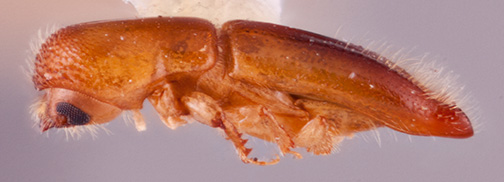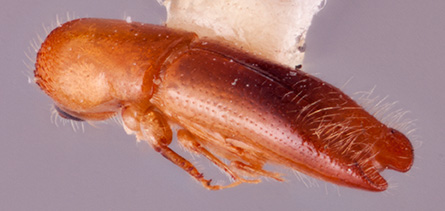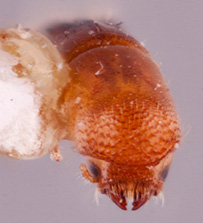Streptocranus bicolor
|
Streptocranus bicolor lateral; R.K. Osborn |
|
Streptocranus bicolor dorsal; R.K. Osborn |
|
Streptocranus bicolor declivity; R.K. Osborn |
|
Streptocranus bicolor frontal; R.K. Osborn |
Taxonomic history
Streptocranus bicolor Browne, 1949: 900.
Coptoborus bicolor (Browne): Wood and Bright, 1992: 662.
Streptocranus bicolor Browne: Hulcr et al., 2007: 582.
Diagnosis
2.4−3.6 mm long (mean = 2.69 mm; n = 5); 4.0−4.17 times as long as wide. 2.4−3.6 mm long (mean = 2.69 mm; n = 5); 4.0−4.17 times as long as wide. This species can be distinguished by its moderate size; strongly attenuateattenuate:
gradually tapering apically
 elytra; and dorsaldorsal:
elytra; and dorsaldorsal:
of or relating to the upper surface; opposite of ventral
 margin of elytralelytral:
margin of elytralelytral:
pertaining to the elytra
process with a minute denticledenticle:
a small tooth, the sides of which are equal and the tip is above the middle of the base (occasionally absent) at the level of the elytralelytral:
(occasionally absent) at the level of the elytralelytral:
pertaining to the elytra
apexapex:
point or edge furthest from the body; opposite of base
 .
.
May be confused with
Streptocranus fragilis, S. mirabilis, and S. petilus
Distribution
East & West Malaysia, Thailand
Host plants
recorded from Dryobalanops, Shorea (Dipterocarpaceae), Eugenia (Myrtaceae) and Palaquium (Sapotaceae); probably polyphagous (Beaver et al. 2014)
DNA data
specimens not available for sequencing





